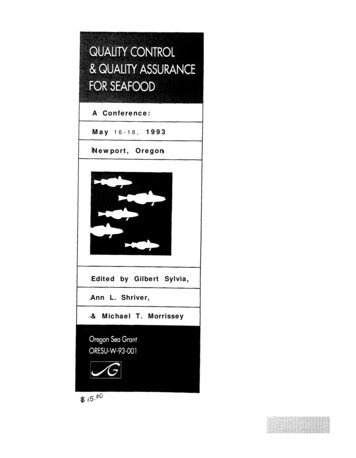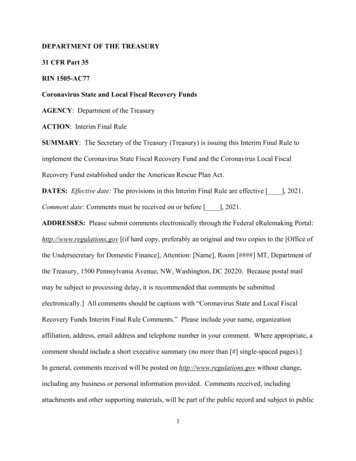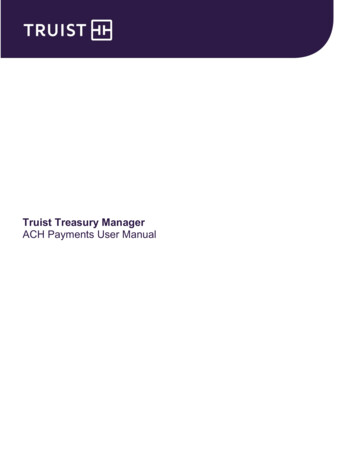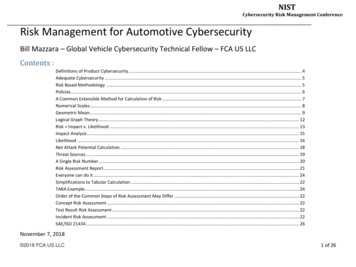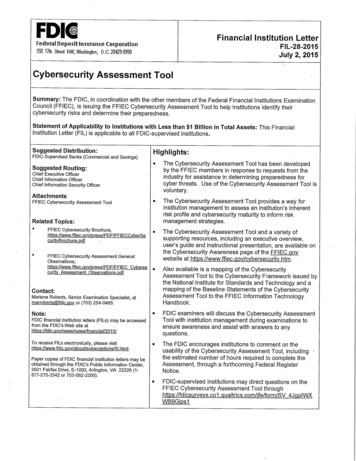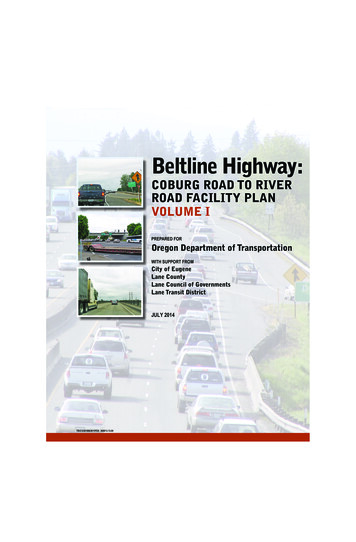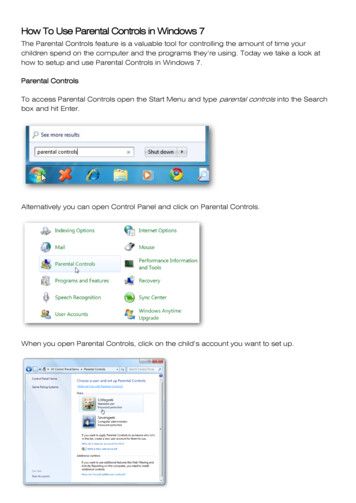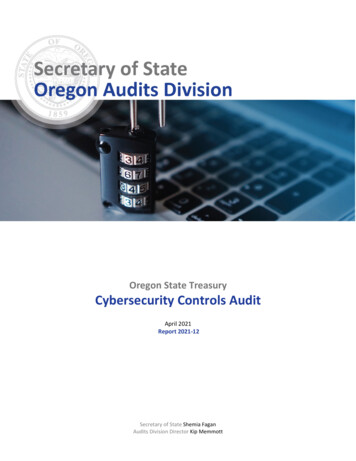
Transcription
Oregon State TreasuryCybersecurity Controls AuditApril 2021Report 2021-12Secretary of State Shemia FaganAudits Division Director Kip Memmott
Oregon State TreasuryWhy This Audit isImportant» The Oregon State Treasury(OST), under the StateTreasurer, acts as the statebanker for the State of Oregonby maintaining all agencyfinancial accounts and byinvesting some state funds,including the state’s TrustFunds and bond fundproceeds.» OST has over 118 billion inportfolio assets under itsmanagement. It processed 16million transactions in 2019worth 294 million.» This audit assessed basiccritical security controls andthe information technology(IT) security managementpractices at OST.» Cyberattacks are a growingconcern for both the privateand public sector. Recentbreaches at Oregon stateagencies have only escalatedthis concern. To protect againstgrowing threats, ITmanagement professionalsshould apply robustcybersecurity controls atvarious levels of infrastructureto protect IT resources.Cybersecurity Controls AuditWhat We FoundOST has a robust security management program that establishes aframework for assessing risk, developing, and implementing effectivesecurity procedures, and monitoring the effectiveness of those procedures.While the audit identifies several opportunities for OST to improvecybersecurity controls, the agency’s focus, investment, and progress towardsmaintaining a secure IT environment is commendable and noteworthy. Theaudit identified the following areas for improvement:1. OST’s IT security plan does not detail how the agency currently addressessecurity for its information resources. Additionally, OST has notdeveloped subordinate security plans that address how key applicationsare appropriately protected. (pg. 4)2. Processes for updating inventory are largely manual and may not fullycapture all hardware assets. Additionally, more controls are needed toensure that only approved devices can connect to OST’s network. (pg. 5)3. OST lacks software policies and procedures, has an incomplete list ofapproved software, and has not implemented whitelisting to ensure onlyauthorized software can be installed on agency systems. (pg. 6)4. More work is needed to ensure that all devices are appropriatelyconfigured and monitored to ensure configuration settings remainappropriate. (pg. 7)5. An additional independent time source should be added to ensure auditlogs time stamps are accurate. (pg. 8)Due to the sensitive nature of IT security and in accordance with Oregon statelaw and government auditing standards, we communicated details of theextent of the security weaknesses we identified to agency management in aconfidential appendix.What We RecommendWe made five recommendations to OST that include improving IT securityplans and remedying weakness we identified in basic CIS Controls . OSTagreed with all of our recommendations. Their response can be found at theend of the report.The Oregon Secretary of State Audits Division is an independent, nonpartisan organization that conducts audits based onobjective, reliable information to help state government operate more efficiently and effectively. The summary above should beconsidered in connection with a careful review of the full report.
IntroductionCyberattacks are a growing concern for both the private and public sector. Recent breaches atOregon state agencies have only escalated this concern. In order to protect against growingthreats, state agency leadership should ensure that information technology (IT) managementprofessionals apply robust cybersecurity controls at various levels of infrastructure to protecttheir networks, servers, and user workstations for the agencies they oversee. State agenciesutilize a variety of frameworks and standards with varying levels of detail to guide these efforts.The Audits Division conducts cybersecurity audits to evaluate IT security risks and provide ahigh-level view of an agency’s current state. We chose to use the Center for Internet Security’sCIS Controls , version 7.1. The CIS Controls are a prioritized list of 20 high-priority defensiveactions that provide a starting point for enterprises to improve cyber defense. The controls aredivided into three categories: basic, foundational, and organizational. This review includes thefirst six, the basic controls, which the Center for Internet Security, along with other securitypractitioners, defined as key controls that every organization should implement for essentialcyber defense readiness.In the following pages, we present the results as graphs depicting how many sub-controls ineach control are not implemented, partially implemented, or fully implemented. This providesagency management, the Legislature, and others with responsibility for cybersecurity in thestate with a snapshot of high-risk areas.This audit does not consider an agency’s risk appetite. Therefore, while these controls areconsidered basic by many security practitioners, agency management may choose not to fullyimplement a control if they determine within their strategic priorities that the cost of doing sooutweighs the risk. In addition, while we generally considered controls that might mitigate someof the risks we identified, we did not perform a detailed review of potential compensatingcontrols for each sub-control.The Oregon State Treasury is exempt from Oregon’s law unifyingcybersecurity under Enterprise Information ServicesIn September 2016, the Governor signed Executive Order 16-13, unifying IT security functionsfor the majority of state agencies in order to protect and secure information entrusted to theState of Oregon. The order directed executive branch agencies to consolidate security functionsinto the Office of the State Chief Information Officer, now known as Enterprise InformationServices (EIS). The passage of Senate Bill 90 in June 2017 made the order permanent.However, multiple state agencies were specifically excluded. These agencies include: Secretary of State;Oregon State Treasury (OST);Attorney General, including the Department of Justice;Oregon State Lottery; andpublic universities listed in ORS 352.002.As such, while Senate Bill 90 resulted in the transfer of 30 security-related positions from stateagencies to EIS, OST retained all its IT security staff and remained solely responsible forachieving and sustaining optimum levels of information confidentiality, integrity, andavailability across the platforms it uses.Oregon Secretary of State Report 2021-12 April 2021 Page 1
OST provides financial stewardship for OregonArticle VI, Section 1 of the Oregon Constitution created OST, which is directed by a statewideelected official, the State Treasurer. State law establishes the powers and duties of the Treasurerand designates the incumbent as the investment officer for the Oregon Investment Council,which is responsible for establishing the state’s investment policy. The State Treasurer alsoserves on the State Land Board and chairs the State Debt Policy Advisory Commission, amongother duties and responsibilities.The mission of the agency is to provide financial stewardship for Oregon. The State Treasureracts as the banker for the State of Oregon by maintaining all state agency financial accounts andby investing state funds not needed to meet current expenditure demands, including the state’strust funds and bond fund proceeds. OST has a 2021-23 proposed budget of over 128 millionand manages a portfolio of over 118 billion as of year-end 2020. In 2019 OST processed 16million financial transactions worth 294 million.OST operates five service areas: State and Local Government Financial Services: Provides banking and short-terminvestment services to all state agencies, most public universities, and services to localgovernments. Also provides central coordination for, and issuance of all Oregon stateagency and authority bonds.Public Savings Services: Oversees several public “defined contribution” investmentprograms, which advance the connected policy goals of increasing individual savings andquality of life, and reducing long-term government costs.Investment Services: Manages funds and trust funds in accordance with policies andasset allocation targets set by the Oregon Investment Council.Trust Property Services: Acts as the depository of record for unclaimed and presumedabandoned property and funds.Oregon Secretary of State Report 2021-12 April 2021 Page 2
Administrative Services: Provides the support needed to ensure the State Treasury andall Treasury programs have the administrative infrastructure, operational resources, andtechnology necessary to fulfill their mission and statutory requirements.The agency procures budget and accounting services from the Department of AdministrativeServices.OST IT Services is located within Treasury’s Administrative ServicesInformation Technology Services is responsible for IT within OST and is located withinTreasury’s Executive Services Division. It supports Treasury by providing a secure and stablenetwork as well as application support for both in-house and external systems. The IT Servicesproposed budget for the 21-23 biennium is 14.7 million and includes 34 positions.As part of its long-term strategic plan, OST has made information security a top priority and hasrequested increased funding for cybersecurity within its 2021-23 budget. The purpose of thisrequest is to help ensure financial transactions and business-critical data entrusted to OST areprotected from evolving and emerging information security threats. OST plans to use theadditional budgeted funds to mature its information security program and meet federal, state,and local government requirements by continuing to improve protections in line with currentfinancial industry best practices.OST has also requested one additional position and related funds to purchase and implementadditional security tools and services to help improve the organization’s security posture andmeet the growing information security needs of OST and its customers.Information Technology Services consists of four teams: Technical Services DeliveryInfrastructure ServicesInformation Security ServicesApplication Development ServicesOregon Secretary of State Report 2021-12 April 2021 Page 3
Audit ResultsOur review determined that OST has a robust security management program that establishes aframework for assessing risk, developing and implementing effective security procedures, andmonitoring the effectiveness of those procedures. While the audit identifies severalopportunities for OST to improve cybersecurity controls, the agency’s focus, investment, andprogress towards maintaining a secure IT environment is commendable and noteworthy.However, our review also identified some areas where OST should improve cybersecuritycontrols.We found that OST has implemented or partially implemented 44 of 47 basic sub-controlsreviewed as part of this audit. Additionally, while not reviewed as part of this audit, we notedthat OST reports to have made significant progress in implementing additional advancedcybersecurity controls recommended by the Center for Internet Security. This progress is largelydue to OST executive management prioritizing cybersecurity and providing full support to theefforts of Information Technology Services.We considered the risks posed by publicly releasing any information related to security findings.As part of our consideration, we balanced the need for stakeholders, such as the Legislature, tobe informed on critical or systemic IT security issues affecting the State against the need toprotect the agency from cybersecurity threats. Consequently, in accordance to ORS 192.345 (23)and generally accepted government auditing standards, we excluded some details of the securityweaknesses from this public report and provided them to agency management in a confidentialappendix.OST has a robust and increasingly mature security management andcompliance program that can benefit from further improvementsEffective security management requires agencies to have policies, plans, and procedures thatdescribe the management program and cover all major systems, facilities, and applications.Detailed roles and responsibilities should be clearly defined. Specifically, agencies should: Periodically assess and validate risks;Document and implement security control policies and procedures;Implement and monitor effective security awareness trainings;Remediate information security weaknesses; andEnsure external third-party activities are adequately secured.We determined that OST has a robust security management and compliance program thatincludes periodic risk assessments, robust security control policies and procedures, securityawareness training, identification and remediation of security weaknesses, and appropriatethird-party security and monitoring.However, while OST has developed an IT Security Plan, we found the plan is largely focused onthe agency’s future state of IT security; it does not address how OST currently achieves securityof its information resources. Additionally, OST has not developed subordinate security plans toaddress how key applications are appropriately protected against unauthorized use, disclosure,or modification.While the plan itself is lacking these details, this does not suggest that appropriate controls arenot in place as demonstrated by the following limited controls review. However, without a welldocumented IT Security Plan that includes the current state of IT security controls, along withOregon Secretary of State Report 2021-12 April 2021 Page 4
subordinate application security plans, existing controls and responsibilities may be unclear,misunderstood, improperly implemented, or inconsistently applied.CIS Controls ReviewFor this audit, we evaluated the implementation level of the agency’s cybersecurity controlenvironment against the top six CIS Controls and their associated sub-controls. We evaluatedeach sub-control to provide an assessment of the agency’s overall cybersecurity implementation.The charts below illustrate the number of controls evaluated for each control objective, andwhether that control is fully implemented, partially implemented, or not implemented.CIS Control 1: Inventory of Authorized and Unauthorized DevicesWe evaluated OST’s processes to identify network devices, maintain an updated inventory ofhardware devices, and ensure only approved devices can connect to the network. We found thatOST has implemented or partially implemented most of the recommended controls over assetinventory.OST utilizes multiple applications and tools to track and monitor systems such as workstations,laptops, printers, servers, and network devices. However, OST’s process for updating inventoryis largely manual and may not fully capture all its hardware assets. Additionally, more controlsare needed to ensure that only approved devices can connect to its network.Any new device introduced to an agency’s network may introduce vulnerabilities. Ensuring onlyauthorized devices have access to information on the agency’s network allows IT professionalsto identify and remediate vulnerabilities by implementing proper security controls. However,without a clear understanding of which devices are on the network, the agency cannot ensureproper controls are in place for those devices. Additionally, without an accurate, up-to-dateinventory of authorized hardware, the agency cannot actively manage and monitor all hardwaredevices on the network so that only authorized devices are given access and unauthorized andunmanaged devices are found and prevented from gaining access.CIS Control 2: Inventory of Authorized and Unauthorized SoftwareOregon Secretary of State Report 2021-12 April 2021 Page 5
We evaluated OST’s process to document approved software, segregate high-risk software, andidentify software installed on its systems. We determined OST has tools in place to identify andtrack software installed on devices connected to its network. However, work remains to ensureonly authorized and supported software is installed on agency systems. Among otherweaknesses, we noted that OST lacked policies and procedures, had an incomplete list ofapproved software, and had not implemented whitelisting to ensure only authorized softwarecan be installed on agency systems.Controls should be established by implementing software whitelisting, automating softwareinventory, and monitoring software installations on all systems. Organizations should maintainan inventory of software installed on their computer systems similar to the inventory of itshardware assets. If an agency does not have a complete, accurate, and up-to-date list of thesoftware authorized to be on its systems, it cannot ensure effective controls are in place toupdate installed software. Attackers continuously scan targeted organizations looking forvulnerable versions of software to exploit. Software that is no longer supported by its vendor isespecially vulnerable to this type of attack, as patches are no longer developed to remediatevulnerabilities.In addition, without an inventory of system software, an agency may be unable to identifyunauthorized software on its information systems, such as malicious software or software withknown vulnerabilities. Attackers can exploit systems with malicious or vulnerable software togain unauthorized access to the agency’s data or disrupt operations. Workstations are also morelikely to be either running software that is unneeded for business purposes, which couldintroduce potential security flaws, or running malware introduced by an attacker after a systemis compromised.CIS Control 3: Continuous Vulnerability Assessment and RemediationWe determined that OST has fully implemented controls to ensure that vulnerabilities areidentified and timely remediated or patched. This includes performing authenticatedvulnerability scanning using appropriate scanning tools, protecting dedicated assessmentaccounts, deploying automated operating system and application patch management tools, andcomparing back-to-back vulnerability scans with an appropriate risk-rating process.Additionally, we tested 10% of OST’s endpoints and found that all were appropriately patchedand up-to-date.Organizations should be continuously engaged in identifying, remediating, and minimizingsecurity vulnerabilities to ensure their assets are safeguarded. Attackers commonly exploit ITsystems that have not been patched with security updates or have other known vulnerabilities.This could compromise the confidentiality, integrity, or availability of agency data. By scanningthe network for known vulnerabilities, an agency can identify and prioritize software patchingand other remediation activities to ensure these known risks are controlled.Oregon Secretary of State Report 2021-12 April 2021 Page 6
CIS Control 4: Controlled Use of Administrative PrivilegesWe assessed OST’s processes to grant privileged access accounts, log and monitor login activity,and to establish robust authentication procedures. 1 We found the agency has strong processesand procedures for granting, reviewing, and terminating access for privileged accounts.Additionally, we found that the agency has robust monitoring of the use of these accounts,including maintaining an inventory of accounts, removal of default passwords, unique passwordrequirements, logging and alerts of account usage, and limits on the use of script tools.We reviewed OST’s privileged accounts and policies to determine if access was set up,monitored, and reviewed on a periodic basis using the principle of least privilege. 2 Overall, wefound that OST has appropriate processes and procedures, but processes to grant, review, andterminate third-party vendor access needs better tracking.Management of privileged users should ensure only authorized users are able to performadministrative functions on the agency’s information systems. While some users may haveauthorization to read, edit, or delete data based on their job duties, other users have access toadvanced functions such as system control, monitoring, or administrative functions. Actionsperformed under these administrative accounts may have critical effects on the agency’ssystems. Therefore, use of accounts with these privileges should be effectively controlled bymanagement, including implementing controls to segregate, manage, and monitor use of theseaccounts.CIS Control 5: Secure Configurations for Hardware and Software on Mobile Devices,Laptops, Workstations, and ServersWe evaluated OST’s processes to document and safeguard baseline configurations, deploysecure configurations, and monitor configurations on its network. We determined OST has1 Privileged access refers to the ability of some users to take actions that may affect computing systems, network communications, orthe accounts, files, data, or processes of other users. Privileged access implies greater access than the average end user has.2 Least privilege is a principal that states that users should have the least amount of privileges (access to services) necessary toperform their duties.Oregon Secretary of State Report 2021-12 April 2021 Page 7
established secure baselines for most servers, network devices, and workstations, but morework is needed to ensure that all devices are appropriately configured and monitored to ensuresettings remain appropriate.Organizations should have processes in place to ensure hardware and software are securelyconfigured. This should include verifying that default configurations align with business andsecurity needs so that agency systems are not left vulnerable to attack. The agency should alsohave configuration management processes in place that address implementing secure systemcontrol features at the initiation of the system lifecycle. Furthermore, an organization shouldensure configurations remain secure as modifications are made to the system. Baselines shouldbe documented so agency personnel can effectively monitor actual configurations to ensure theyalign with established baselines. Also, policies and procedures should be in place that addresshow configuration baselines are managed.CIS Control 6: Maintenance, Monitoring, and Analysis of Audit LogsWe reviewed OST’s processes for collecting, managing, and analyzing audit logs of events thatcould help the agency detect, understand, or recover from an attack. We found that OST has fullyimplemented controls over the maintenance, monitoring, analysis of audit logging. This includesenabling detailed audit logs for all network devices and endpoints, ensuring adequate logstorage, centralized log management, reviewing logs on a regular basis, establishing appropriatelog alerts, and procedures for regularly tuning the log management system. However, OSTshould take steps to ensure the agency has an adequate number of independent time sources tofurther ensure audit logs time stamps are accurate.Robust logging and log monitoring processes allow organizations to identify and understandinappropriate activity and recover more quickly from an attack. Deficient logging may allowattackers and malicious activity to go undetected for extended periods. Moreover, attackersknow that many organizations rarely review log information, allowing attacks to go unnoticed.Agencies should ensure that information systems record the type, location, time, and source ofevents that occur. Additionally, processes should be established to ensure these logs areperiodically reviewed so the agency can identify inappropriate or unusual activity and remediatesecurity events.Oregon Secretary of State Report 2021-12 April 2021 Page 8
RecommendationsTo improve critical cybersecurity controls, we recommend OST:1. Update IT security plans to include all necessary elements, including the current state ofIT security and subordinate security plans.2. Remedy weaknesses with CIS Control #1 — Hardware Inventory — by fully automatingasset discovery and inventory and fully implementing hardware authentication controls.3. Remedy weaknesses with CIS Control #2 — Software Inventory — by updatingdocumentation of approved software, ensuring software is supported by its vendor, andimplementing software whitelisting.4. Remedy weaknesses with CIS Control #5 — Secure Configurations — by establishingsecurity configuration for all servers and network devices and strengtheningconfiguration monitoring and alerts to ensure all changes to configuration areauthorized and appropriate.5. Remedy weaknesses with CIS Control #6 — Audit Logs — by establishing an adequatenumber of independent time sources to ensure audit logs time stamps are accurate.Oregon Secretary of State Report 2021-12 April 2021 Page 9
Objective, Scope, and MethodologyObjectiveOur audit objective was to determine the extent to which OST has implemented an appropriateIT security management program, as well as selected controls from the Center for InternetSecurity’s CIS Controls , version 7.1. 3 These controls are a prioritized set of actions thatcollectively form a defense-in-depth set of best practices to help protect systems and networksfrom the most common attacks. 4ScopeThe scope of this work included a review of security management and the first six of the 20 CISControls in place at OST during the third and fourth quarters of 2020. Cybersecurity expertsgenerally agree that these six “basic” controls should be implemented by all organizations forcyber defense readiness.The following internal control principles were relevant to our audit objective: 34Security Managemento Establish a security management program;o Periodically assess and validate risks;o Document and implement security control policies and procedures;o Implement effective security awareness and other security-related personnelpolicies;o Monitor the effectiveness of the security program;o Effectively remediate information security weaknesses; ando Ensure that activities performed by external third parties are adequately secure.Inventory and Control of Hardware Assetso Actively manage (inventory, track, and correct) all hardware devices on thenetwork so that only authorized devices are given access, and unauthorized andunmanaged devices are found and prevented from gaining access.Inventory and Control of Software Assetso Actively manage (inventory, track, and correct) all software on the network sothat only authorized software is installed and can execute, and that allunauthorized and unmanaged software is found and prevented from installationor execution.Continuous Vulnerability Managemento Continuously acquire, assess, and take action on new information in order toidentify vulnerabilities, remediate, and minimize the window of opportunity forattackers.Controlled Use of Administrative Privilegeso The processes and tools used to track/control/prevent/correct the use,assignment, and configuration of administrative privileges on computers,networks, and applications.Secure Configuration for Hardware and Software on Mobile Devices, Laptops,Workstations and Serverso Establish, implement, and actively manage (track, report on, correct) the securityconfiguration of mobile devices, laptops, servers, and workstations using aCenter for Internet Security CIS ControlsDefense-in-depth refers to the application of multiple countermeasures in a layered or stepwise manner to achieve securityobjectives.Oregon Secretary of State Report 2021-12 April 2021 Page 10
rigorous configuration management and change control process in order toprevent attackers from exploiting vulnerable services and settings.Maintenance, Monitoring and Analysis of Audit Logso Collect, manage, and analyze audit logs of events that could help detect,understand, or recover from an attack.Deficiencies with these internal controls were documented in the audit results section of thisreport. Other elements of internal control were not deemed necessary to achieve the objective ofthe audit and were excluded from scope.MethodologyTo assess whether management has established policies and implemented controls to stopcyberattacks that may target the agency, we:Reviewed: IT Policies and procedures; External IT risk assessments and audits; Hardware asset inventory lists; Software asset inventory lists; Privileged user access lists; Network diagrams.Observed: Configuration settings; Vulnerability scan results; Software installed on workstations; IT processes and ad hoc activities.Interviewed: IT staff; IT managers; Agency Director of IT; Agency leadership.We considered the risks posed by publicly releasing any information related to security findings.As part of our consideration, we balanced the need for stakeholders, such as the Legislature, tobe informed on critical or systemic IT security issues affecting the State against the need toprotect the agency from cybersecurity threats. Consequently, in accordance to ORS 192.345 (23)and generally accepted government auditing standards, we excluded some details of the securityweaknesses from this public report and provided them to agency management in a confidentialappendix.We conducted this performance audit in accordance with generally accepted governmentauditing standards. Those standards require that we plan and perform the audit to obtainsufficient, appropriate evidence to provide a reasonable basis for our findings and conclusionsbased on our audit objective. We believe that the evidence obtained provides a reasonable basisto achieve our audit objective.We sincerely appreciate the courtesies and cooperation extended by officials and employees ofOST during the course of this audit.Oregon Secretary of State Report 2021-12 April 2021 Page 11
DocuSign Envelope ID: 83355D1D-DEEC-41C8-9C2F-C5A008DBC2DCApril 8, 2021Kip Memmott, DirectorSecretary of State, Audits Division255 Ca
audit identif ied the following areas for improvement : 1. OST's IT security plan does not detail how the agency currently address es . Information Technology Services is responsible for IT within OST and is located within . additional security tools and services to help improve the organization's security posture and
